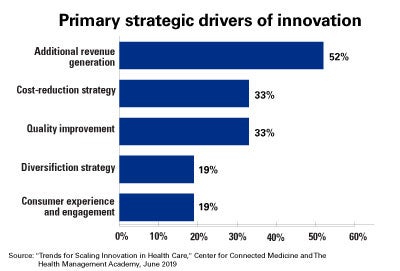

Get Your Innovation Efforts Up to Scale and Up to Speed
 Hospitals and health systems are accelerating efforts to drive innovation, but they haven’t mastered the ability to scale their ideas quickly. In fact, a new study from the Center for Connected Medicine and The Health Management Academy shows that 62% of responding health systems scale innovation slowly or very slowly.
Hospitals and health systems are accelerating efforts to drive innovation, but they haven’t mastered the ability to scale their ideas quickly. In fact, a new study from the Center for Connected Medicine and The Health Management Academy shows that 62% of responding health systems scale innovation slowly or very slowly.
Among the 38% of organizations that indicated they can scale and implement innovation quickly, the vast majority attribute part of their success to having a formal process for innovating. These processes include things like expediting approvals from their legal departments and other key stakeholders and allowing pilot projects to get up and running quickly.
The study, based on surveys and interviews with executives from 28 health systems, also found that 60% of respondents focus primarily on internal innovation. As for the primary strategic drivers of innovation, slightly more than half of respondents said generating additional revenue, followed by cost reduction and quality improvement.

Based on the research findings, The Academy and CCM offer these six tips for scaling innovation:
Define innovation: Create a system-level definition for innovation, with C-suite buy-in. Respondents’ definitions for innovation suggest a quest for new value that leads with problem-solving, supported by technology.
Align with goals: The research suggests decision-making around innovation is heavily connected to alignment with existing organizational strategic goals. Top functional areas for innovation at health systems center on areas like access, information technology/data analytics and patient engagement.
Structure people and process: Create a formal innovation department and scaling process to support efficiency across your system. A correlation exists between health systems that have structure and processes around innovation and the ability to implement and scale innovation quickly, the study found.
Empower decision-makers: Allocate a dedicated budget and appoint an executive with decision-making power for innovation strategy. This person typically reports to the CEO. Survey data showed that large health systems are most likely to have a separate innovation department, compared with that of small- and medium-sized systems.
Simplify signoff: If you want to speed scaling of innovation, reduce the number of people involved in decision-making for this area. Organizations that report being able to reach decisions somewhat quickly around innovation scaling did not list board members as stakeholders in the process.
Maximize strengths: Innovative health systems recognize their strengths and capabilities and supplement areas where they need help by partnering with others. The most common external partners, respondents said, are tech firms and academic institutions.



